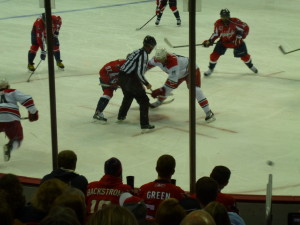22 October 2015
RED ARMY (dir. Gabe Polsky, cert. 15)
Film review by Neil Tidmarsh
A documentary film? About ice hockey? About the Soviet Army ice hockey team?
No, no, wait, please don’t click off this page (at least not yet). It really is a terrific film. Honestly. It’s about so much more than ice hockey. It’s about Russia, and the Cold War, and the collapse of the Soviet Union. And even more than that it’s about human beings and that eternal, universal question – how much freedom does the state owe the individual, and how much loyalty does the individual owe the state?
It’s the story of Slava Fetisov, the captain of the Red Army hockey team in the 1980’s, and follows his career as star-player and then rebel, victim and outcast. The team was only nominally an army team – it was really the national team which happened to be run by the military. Each year, young boys aged ten or eleven auditioned by the thousand. The few who were selected spent the rest of their playing lives in a sealed-off institution where sporting excellence was relentlessly pursued.
In many ways it confirms our suspicions about Soviet Russia – that it was more or less a slave state, for instance. The state in effect owned the players, particularly after the avuncular and artistic Anatoli Tarasov was replaced as trainer by the KGB-backed tyrant Viktor Tikhonov. At one point there’s some brief footage of circus bears on skates playing ice hockey; it’s only a few seconds, but long enough to make you think “Poor creatures… but hang on, the human players were treated little better than animals themselves…”
And yet there are surprises. The style of hockey produced wasn’t the simple fighting game you might expect from its military foundations. It was subtle, complex and beautiful, putting great emphasis on creative play, sophisticated technique and, above all, collective effort. Its practitioners insisted that it was an art form. They come across as artists single-mindedly pursuing a pure vocation as much as politicised storm-troopers. They trained alongside the Soviet chess team and the Bolshoi ballet, incorporating the intellectual rigour of the one and the gymnastic grace of the other. And they aren’t the dehumanised, brutalised robots you might expect, either. They’re clearly nice guys, good guys, kind and honest, who relied on each other off the ice as much as on it, and whose ideals of honour, loyalty and patriotism are personal and sincere rather than the mindless results of brain-washing and indoctrination. And they were shocked by the violent, ugly, basic and individualistic play they encountered in North America. It surprised them as much as their easy initial victories over the USA and Canada surprised the North Americans.
The film follows the epic clashes in the Olympic Games between East and West, between Soviet Russia and democratic Canada and the USA, clashes which were seen as a metaphor for the Cold War even at the time, and which each side consciously acknowledged as a way of proving the superiority of its own system and way of life. It follows the exodus of Russian players to the NHL (the lucrative North American professional league) after the collapse of Communism, a move which itself is symbolic of the fall of the Soviet Union and the rise of a new, individualistic and materialistic Russia. But most of all it follows the trials and tribulations of Slava Fetisov as he is built up and then broken down by the Soviet system, attempts to find his feet in the USA and tries to build bridges between North America and Russia, his integrity and patriotism miraculously intact. Today he is Russia’s Minister for Sport.
The film consists of interviews and archive footage. The unseen interviewer (presumably the director Gabe Polsky) might at first strike you as irritatingly inarticulate – but then you realise that his approach (learnt from Louis Theroux perhaps) is deliberate – disingenuous, disarming and anything but naïve – and eases surprising revelations out of his subjects (though Slava Fetisov clearly isn’t fooled by it, and it amusingly sends itself up in places). Don’t miss this film if you’re even remotely interested in Russia, the Cold War, modern history or simply the very human conflict between the individual and authority. You might actually be a little disappointed if you’re a hard-core ice hockey fan, as it’s about so much more than just this most exciting of sports.
Incidentally, if you’re ever in Toronto, don’t miss that city’s Ice Hockey Hall of Fame. It screens a gripping documentary feature specifically about those Cold War clashes between the Canadian ice hockey team and the Soviet ice hockey team, telling it from the Canadian point of view and complementing RED ARMY rather nicely, even though it’s more overtly about the sport.
The Hall of Fame is worth a visit anyway; a few years ago I was on holiday in Toronto and, even though the guide book promoted it as a must-see attraction, I thought “Ice-hockey? What’s that about? No, won’t bother with that.” But I went anyway – don’t remember what changed my mind – and now here I am, sitting in my Toronto Maple Leafs shorts and my Montreal Habs t-shirt, looking forward to watching the Washington Capitals at the Verizon this time next week (my co-editor will have to publish issue 26 of Shaw Sheet without me – sorry!) and writing about the Red Army team.
And that’s after a weekend of watching the thrilling Rugby World Cup Quarter Finals.



